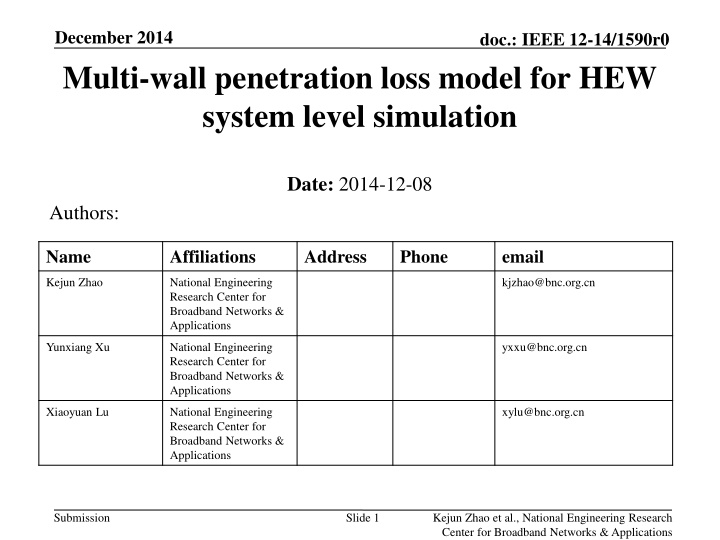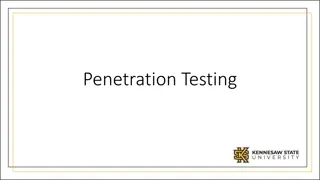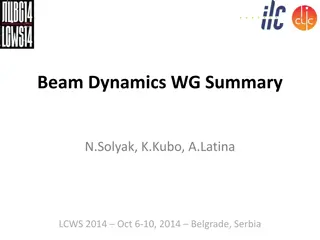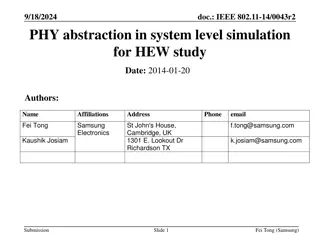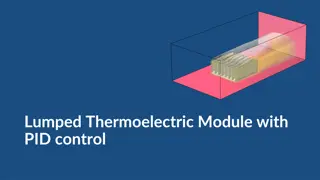Analysis of Multi-Wall Penetration Loss Model for HEW System-Level Simulation
In December 2014, a multi-wall penetration loss model for HEW system-level simulation was proposed by Kejun Zhao, Yunxiang Xu, and Xiaoyuan Lu from the National Engineering Research Center for Broadband Networks & Applications. The model provides more accurate calculations of penetration loss in indoor environments with different wall materials. Various scenarios and considerations for wall penetration loss in different frequencies and materials were discussed, emphasizing the need for a precise model to account for varying wall compositions. Additionally, research studies on penetration loss measurements for different materials were referenced to support the model's development.
Download Presentation

Please find below an Image/Link to download the presentation.
The content on the website is provided AS IS for your information and personal use only. It may not be sold, licensed, or shared on other websites without obtaining consent from the author.If you encounter any issues during the download, it is possible that the publisher has removed the file from their server.
You are allowed to download the files provided on this website for personal or commercial use, subject to the condition that they are used lawfully. All files are the property of their respective owners.
The content on the website is provided AS IS for your information and personal use only. It may not be sold, licensed, or shared on other websites without obtaining consent from the author.
E N D
Presentation Transcript
December 2014 Multi-wall penetration loss model for HEW system level simulation doc.: IEEE 12-14/1590r0 Date: 2014-12-08 Authors: Name Affiliations Address Phone email Kejun Zhao National Engineering Research Center for Broadband Networks & Applications kjzhao@bnc.org.cn Yunxiang Xu National Engineering Research Center for Broadband Networks & Applications yxxu@bnc.org.cn Xiaoyuan Lu National Engineering Research Center for Broadband Networks & Applications xylu@bnc.org.cn Submission Slide 1 Kejun Zhao et al., National Engineering Research Center for Broadband Networks & Applications
December 2014 doc.: IEEE 12-14/1590r0 Abstract In indoor environments, such as Scenarios #1 and #2, penetration loss of walls made of different types of materials are different. We will provide our multi-wall penetration loss model which can give a more precious pass loss calculation for HEW system level simulation. Submission Slide 2 Kejun Zhao et al., National Engineering Research Center for Broadband Networks & Applications
December 2014 doc.: IEEE 12-14/1590r0 Background In [1], four different kinds of scenarios are considered, the first three for indoor environment and the last one for outdoor environment. The pass loss defined in Scenarios #1 and #2 is PL PL = + + PL PL overall indoor floor wall Scenario ??????? ???????? ?????? 1 40.05 + 20*log10(fc/2.4) + 20*log10(min(d,5)) + (d>5) * 35*log10(d/5) 18.3*F^((F+2)/(F+1)-0.46) 5*W 2 40.05 + 20*log10(fc/2.4) + 20*log10(min(d,10)) + (d>10) * 35*log10(d/10) N/A 7*W d = max(3D-distance [m], 1), fc = frequency [GHz], W=number of walls traversed in x-direction plus number of walls traversed in y-direction Submission Slide 3 Kejun Zhao et al., National Engineering Research Center for Broadband Networks & Applications
doc.: IEEE 12-14/1590r0 Wall Penetration Loss We agree to calculate total wall penetration loss as the sum of those of walls traversed in x-direction and y-direction. However, we think it is unreasonable to set wall penetration loss to fixed 5 dB in SS1 and 7 dB in SS2. On one hand, different kinds of wall may have different penetration loss because they are made of different types of materials such as concrete, brick, plywood, etc. while some wall is made of two or more materials. On the other hand, one wall also may have different penetration loss on 2.4GHz and 5GHz. This presentation will provide several research results about the penetration loss of different kinds of wall and give a more precious model. Submission
doc.: IEEE 12-14/1590r0 Penetration loss measured on 2.4GHz Y. E. Mohammed et al. (2003) measured five types of materials, including 12mm glass, 8mm chip wood, 38mm thick wood, 250mm concrete wall and 40mm door, in vertical and horizontal polarization. M. Najnudel (2004) considered more types of materials, including Window (metallic ink or not), thin\media\thick wood wall, thick concrete, plane of glass, brick wall (with or without window), which are the most common indoor obstacles. Submission
December 2014 doc.: IEEE 12-14/1590r0 Penetration loss measured on 5GHz (1/2) NIST proposed a report on Electromagnetic Signal Attenuation in Construction Materials , which deeply researches the penetration loss for many different types of materials on frequency in the range of 3GHz to 8GHz. Submission Slide 6 Kejun Zhao et al., National Engineering Research Center for Broadband Networks & Applications
December 2014 doc.: IEEE 12-14/1590r0 Penetration loss measured on 5GHz (2/2) Based on the NIST report, the penetration loss value for the considered materials on 5GHz are provided. Material 5GHz Material 5GHz Brick 15.2806 Reinforced Concrete 53.7989 Masonry Block 14.9250 Drywall -0.2153 Concrete (102mm) 26.0008 Glass 0.0688 Concrete (203mm) 55.1581 Lumber 3.2778 Brick-Faced Concrete Wall 39.8953 Plywood -0.1852 Brick-Faced Masonry Block 32.6320 Note that drywall and plywood may enhance the power of signal on 5GHz. Submission Slide 7 Kejun Zhao et al., National Engineering Research Center for Broadband Networks & Applications
December 2014 doc.: IEEE 12-14/1590r0 Suggestion on wall penetration loss According to these research results, walls made of different types of materials may have significant difference on penetration loss. We suggest to divide walls into four types: Load-bearing wall, which are commonly made of reinforced concrete. Non-bearing wall, which are commonly made of concrete. Board, which are commonly made of wood. Others, such as brick wall. One wall have slightly difference on penetration loss between 2.4 GHz and 5GHz. For simplicity, the difference can be ignored. Submission Slide 8 Kejun Zhao et al., National Engineering Research Center for Broadband Networks & Applications
December 2014 doc.: IEEE 12-14/1590r0 Multi-wall Penetration Loss Model Total wall penetration loss included in pass loss is calculated as the sum of penetration loss of walls traversed in x-direction and y- direction, which are indexed by 1,2, ,W. Each type has a penetration loss calibration ??,? = ?,?,?,?. W PL = = ( ) wall w T w 1 w T ? denotes the type of wall. ??< 1 is a loss factor which depends on the status of the wall, like with/without a window, a door, or a hole. Type Penetration loss calibration ? 1 Load-bearing wall 40dB 2 Non-bearing wall 30dB 3 Board 5dB 4 Others 15dB Submission Slide 9 Kejun Zhao et al., National Engineering Research Center for Broadband Networks & Applications
December 2014 doc.: IEEE 12-14/1590r0 Summary It is necessary to consider the types of wall when calculating wall penetration loss. A more precious multi-wall penetration loss model is proposed which can be used in indoor environments, such as Scenarios #1 and #2. The measurement of loss factor ?? in slide 9 will be one of our future works. Submission Slide 10 Kejun Zhao et al., National Engineering Research Center for Broadband Networks & Applications
December 2014 doc.: IEEE 12-14/1590r0 References [1] 11-14-0980-05-00ax-simulation-scenarios. [2] 11-14-0882-04-00ax-tgax-channel-model-document. Submission Slide 11 Kejun Zhao et al., National Engineering Research Center for Broadband Networks & Applications
